Big data allows companies to analyse and assess information about their customers, sales, marketing, and every other element of their business. Since most companies have data across numerous platforms, they need to migrate it into one repository so that it can be organised and accessed for use. Data transformation is a part of pulling all the data from other sources and making it usable.
With up to 68% of data available to businesses not being leveraged you want to make sure you can transform data into something that can be used.
It is kind of like an interpreter. When you have many people present, all of whom speak different languages, you want someone who can understand what everyone is saying.
There are several data transformation tools and methods, many of which are automated. This automation allows tech professionals to focus on other tasks while giving decision makers everything they need to generate reports and interpret the data.
Data transformation isn’t the entire process, from start to finish. It is just one step – though significant – that enables users to understand all of their data better, no matter where it originated.
What Is Data Transformation?
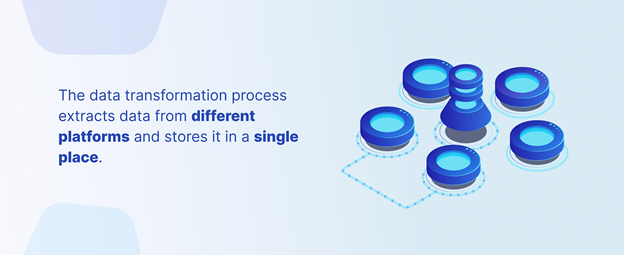
Data transformation may only be one part of the more extensive data migration process, but ensuring that all the data is usable is essential. This part of the process begins with extracting data from the different sources, cleaning the data, and converting it into a single format for more accessible analysis.
Data transformation is different from data integration:
- Data integration provides a single view of data across multiple different platforms.
- The data transformation process extracts data from the different platforms and stores it in a single place, usually a data warehouse.
The primary purpose of the data transformation is to allow the user to manage their data. It can be a straightforward process, such as converting data from a text file into a spreadsheet. This process is something that most people have done before if they have had to work with a database. Though it doesn’t seem impressive, this is a simple example of how helpful data transformation can be.
However, most of the time, when people talk about data transformation, they mean a much more complex process. The majority of raw data comes from a wide range of sources. To properly analyze all of that raw data, it will take a more robust process to ensure it is reliable.
Simpler data sets can be easily placed in charts and graphs. More complicated data sets, such as data warehouses, can be accessed through tools and SQL to pull selected points. Whether simple or complex, the result is to leverage the data to gain better insights. Without data transformation, it would be far more challenging to work with the data, and it would be nearly impossible to work with big data.
Essentially, if you transform data from multiple sources into a single repository, you will be able to put your data to good use, knowing that it is more accurate and complete.
How Data Transformation Works
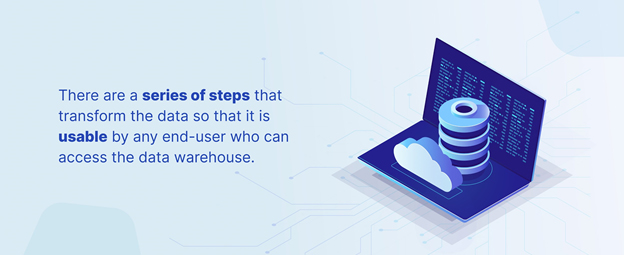
There are three primary stages to more complicated data transformations:
- Extract
- Transform
- Load
As with many technical terms, it is often boiled down to an acronym used when communicating: ETL. People in tech are likely to call it ETL because it is easier to say and type.
The process starts with identifying what data should be extracted before pulling it. Once all relevant data is extracted from all desired sources, it is moved to a single location, better known as a repository. This process is done through data mapping. Next, the process goes through and cleans the data based on set parameters and desired format. When it is ready, the freshly cleaned and formatted data can be used by various analytical tools and apps to be interpreted.
Following the cleanup of the data, there are a series of steps that transform the data so that it is usable by any end-user who can access the data warehouse.
- Data discovery is the first post-cleansing step. Typically a profiling tool is used to identify and understand the data in the original format.
- With the data identified, the data mapping step begins. As the name suggests, it maps out the process going forward.
- Next, the process generates code to run the transformation.
- Once the code is generated, the process executes the code, resulting in the code being converted into the desired format. This format should be the same for all other data in the repository.
- The last step is to verify that the data is formatted correctly.
These are the essential steps to transform the data so that it is in a uniform format. However, you likely know that working with data requires a lot of other small details. You can include some additional steps in the process to target specific data, enhance what is available, and remove duplicate data entries.
The following steps are frequently added to the process to provide a more targeted look at the data so that it is more quickly accessible:
- Filtering allows you to load columns that you specify to be loaded.
- Enriching focuses on specific data points, such as particular fields.
- Splitting lets you divide an individual column into multiple columns.
- Joining lets you pull data from several sources at one time.
- Duplicate data removal ensures that you don’t skew the data.
You can run just the basic steps or add detailed steps to transform your data. Once you are done converting data, you can start using it for making decisions and understanding the market.
The Different Types of Data Transformation
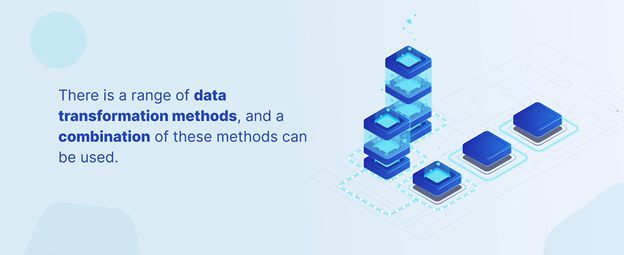
With such a wide range of potential methods of transforming data, you need to understand the different types to make the best decisions about how to transform your data. You won’t need to use all of these, but you will likely use a combination of these different types to make the most out of your data.
- Bucketing and binning is the best method to manage numeric series data to categorize them and establish ranges. Consumer prices are probably the most common type of data for bucketing and binning. Since these types of data can wildly fluctuate, this method will make it a lot easier to interpret and understand trends.
- Data aggregation is one of the most robust types. It includes searching and gathering data and then summarizing it for reporting and presenting. This method is beneficial for comparing a wide range of data points, such as understanding employee salaries based on gender, race, age, department, and other factors. Data aggregation is ideal for managing business intelligence.
- Data cleansing makes sure that your data is accurate, complete, and current. It also looks for missing data values and ensures that you address those missing values. Essentially, this is a way of scrubbing your data to be more reliable.
- Data deduplication removes all duplicate data entries or repeated data points.
- Data derivation is a method of focusing on specific data that you want to be pulled from the source. Your database contains a wealth of data about sales revenue, but you may only want to access the total profit after all costs and taxes are removed. Data derivation is the method you will use to pull the specific type of data, then do the subtraction so that the only data you see after the transformation is the total net profit.
- Data filtering lets you refine the data that you want to review. You’ve probably used the filter feature in spreadsheets – it’s the same idea but with a lot more data and culling to provide just the particular data you need at the time.
- Data integration merges data from different sources and puts them in the same format after reconciling differences.
- Data joining is probably the type of data transformation you will use most often. Often SQL is used to pull and connect data from different tables based on a common element, such as a column that both tables have in common.
- Data splitting is pretty straightforward – it simply divides one column into as many columns as needed.
- Data summarization is a simpler version of data integration, focusing more on the numeric side of data. It is often used for creating metrics through specified calculations to derive totals.
- Data validation is essential as it requires the creation of rules and algorithms to manage a range of issues with the data. It is one of the methods of cleaning up the data to ensure accuracy.
- Format revisions manage the different types of data to provide a more uniform presentation of the data. The most common types of data are text and numeric, for example, dates provided in text format and others in numeric format.
These are the most commonly used types of data transformation, and they are the ones you will likely use. There are several more complicated versions, but they are used primarily by tech-savvy people who can set up data keys to restructure the data.
Whichever method is used, transformed data will be easier to work with once the process is complete.
Benefits of Data Transformation
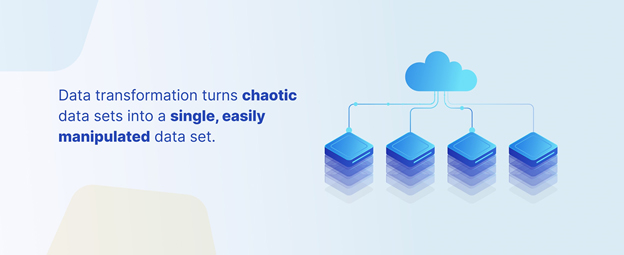
If you’ve ever looked at the raw data from multiple platforms in their many different formats, you know precisely why data transformation is beneficial. It turns the chaotic data sets into a single, easily manipulated data set. The result is still too much data to review by a single person – you will want to have analytical tools to make sense of the data. It is much easier for tools to work with the data once it is in a single format and stored in one location.
This increased accessibility is the primary benefit, but it can be broken down into four categories that benefit everyone who uses the data.
- By transforming data into a single format, companies have improved the accessibility and usability of their big data.
- It is a much more effective way to manage data as it is refined and clean, particularly compared to the original formats.
- You can significantly expedite the query process.
- The data is of higher quality since it has been cleaned up before being moved to a single repository.
These don’t seem like much unless you’ve tried to work with data from several different sources. Data stored on various software applications is complicated to assess and analyze, even within a company.
Every department can benefit from data transformation because every manager has to make decisions. This process makes it a lot easier to make an informed decision without spending hours trying to interpret the data. Queries are more effective and can generate more concise reports with clear conclusions to speed up the decision process.
Challenges of Data Transformation

If you’ve dealt with data from many sources, you would be aware of the challenges of data transformation. It’s the same for data transformation tools, but they can deal with data faster and more accurately. While data transformation can do a lot, with really messy or chaotic data, there are more likely to be problems with the process. These problems include:
- Most types of data transformation are incredibly complex, and the process can be very time-consuming.
- Experts are generally needed to ensure the integrity of the data. The experts can help establish an automated system to manage the process better. This typically means that you need to hire help from external sources because you aren’t likely to need these experts full-time.
- The process can be overwhelming, and experts need a lot of input from you and the people who understand the data to ensure it is properly transformed.
- Considering every aspect and department of the business rely on the data, staff from all areas need to buy into the process. Not only do you need buy-in, you need people to agree on the path forward.
With more reliable data and reports, you have a better foundation for your business decisions. The challenges aren’t overwhelming, and the payoff for seeing through to establishing a reliable method of transforming data is easily one of the most rewarding things you can do for your business. All that upfront hassle and pain translates into saving hours every quarter in managing your data.
Examples of Data Transformation
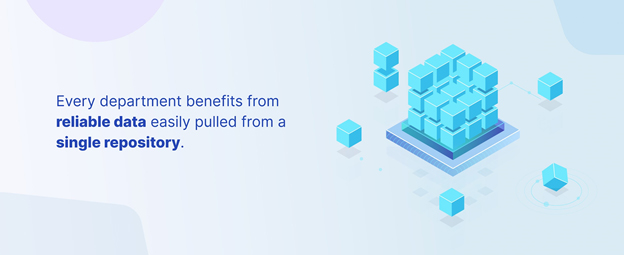
Every department can benefit from a streamlined data transformation process.
- Any department that deals with costs will be able to predict costs better, understand costing trends, and adjust based on those predictions.
- Since companies tend to be intensely interested in profit, the finance department will have all the tools and clean data they need to reconcile accounts, establish budgets, and understand profit margins.
- Projects that have been costed and milestones established can be better tracked and potential issues predicted before they occur. For example, if a client requests something out of scope, it will be easier to determine if the addition can be done based on the current timeline and within the budget. If not, it is easier to negotiate changes or provide a new estimate for the out-of-scope work.
Though people, particularly executives, usually focus on the financial end, every department benefits from reliable data easily pulled from a single repository.
Data Transformation Tools
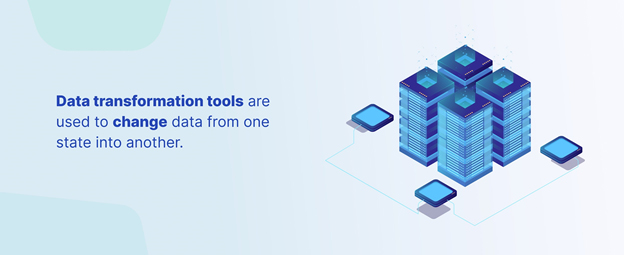
Perhaps the trickiest question is which tool to use, as the tools used to transform data change, with new ones being introduced and old tools being retired regularly. For example, the cloud required a different tool than the previous servers and systems. Keeping in mind that the tech and tools are constantly changing, below are the data transformation tools that are currently commonly used for the best results.
It is possible to conduct manual data transformation, but most of the time, it isn’t recommended. These tools can incorporate failover features, monitoring, and parallelization to manage data better. The right ETL tools provide custom code that will reliably run and provide data regularly required for decision making. The best reason to use ETL tools is that they save time while delivering highly reliable data.
Hand coding is an option. There are some downsides to it, including the need for a greater understanding of what code is needed. It is also less reliable as manual creation of the code on the fly increases the odds of introducing errors. Even if it is flawless, it is difficult to replicate. This means there is a higher cost. However, there remains a need for this occasionally as sometimes there isn’t time for using a more complicated tool.
You’ll probably end up with a favourite data transformation tool, but knowing that you have options will make sure you find the right tool for different types of transformation.
Final Thoughts
With a better understanding of data transformation and the much larger task of managing data, you have the details you need to decide the next move for your company. Whether you need data migration services, an assessment of your data transformation needs or help with data integration we can help.
The data transformation process is complicated, but with so many benefits it’s worth having a robust process. If you are ready to start your data transformation process, we have specialists ready to answer your questions and get you started down the path to better data management.

